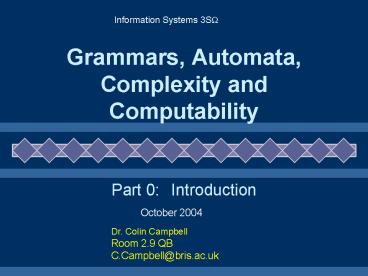Grammars, Automata, Complexity and Computability - PowerPoint PPT Presentation
1 / 22
Title:
Grammars, Automata, Complexity and Computability
Description:
formal approach to information measurement and communication ... accents, dialect, tonal inflection, etc. Too difficult for this course! ... – PowerPoint PPT presentation
Number of Views:87
Avg rating:3.0/5.0
Title: Grammars, Automata, Complexity and Computability
1
Grammars, Automata, Complexity and Computability
Information Systems 3S?
October 2004
Dr. Colin Campbell Room 2.9 QB C.Campbell_at_bris.ac.
uk
2
Information systems
- Part 1 - Theory of discrete information and
communication systems - formal approach to information measurement and
communication - e.g. estimate how much information a channel can
carry - Part 2 - Grammars automata, computability,
complexity - formal approach to information representation and
manipulation systems - e.g. 1. information as natural language 2.
predicting time it takes to solve a problem
3
Course Outline
- Grammars
- Formal models of grammar for use in modelling
the structure of computer languages and natural
language - Grammars generate sentences
- Automata
- An introduction to finite automata as abstract
machines - An introduction to push-down automata and their
applications - Examine how automata relate to formal grammars
- Automata accept sentences
4
Course Outline II
- Complexity
- Complexity of algorithms and the Travelling
Salesman problem - Turing machine as the most general automaton, and
RAMachines - Computability
- The Church-Turing thesis
- Complexity classes P, NP and NP-complete
- Heuristics for the Travelling Salesman problem
- The Halting Problem
5
How are grammars, automata, complexity and
computability linked?
6
Relating components
channel
Information
Information
I
I
machine
machine
7
Introduction to Grammars
- Why use grammars?
- basis for
- natural language processing
- programming languages
- symbolic structures
- all of which represent information
- used in
- written text
- spoken language
8
Good ? and bad ? points
- ? sentences can be incomplete descriptions of
what they are intended to convey - e.g.
- My children have gone out to play
- Peter and Fred have gone out to play
- Peter and Fred have gone out to play football
- ? we can be as vague or precise as we like. We
can leave out information if we think the other
person already knows it.
9
Good ? and bad ? points
- ? Many different ways of saying things
- e.g.
- I was born on July 3
- Jonathans birthday is the third of July
- ? rules are natural if we have enough background
information - e.g.
- If person X was born on date D then Xs birthday
is date D
10
Written languages
- Process using
- lexical (morphological) analysis,
- syntactic analysis,
- semantic analysis,
- and contextual knowledge
11
Lexical (morphological) analysis
- Check that each symbol in a sentence is valid
- e.g.
- I envy Freds computer ?
- I en vy Fre ds computer ?
- classify symbols into syntactic categories
- nouns Fred, I
- verbs to envy
- possesive s
- etc.
12
Syntactical analysis
- Convert flat list of words (or symbols) into a
structure that is defined by the syntactic types
of the words - e.g.
- simple breakdown of sentence based on structure
13
Semantic analysis
- 1. Maps words onto objects in knowledge base
- e.g. in our context
- I maps to object Jonathan, a lecturer
- Freds computer maps to object Pentium 450MHz
- envy maps to a known mental state like
jealousy, etc. - 2. Creates internal structure among objects
corresponding to how the words combine together - e.g.
- links Jonathan to jealousy
- links jealousy to Pentium 450MHz, etc.
- Further contextual processing is now performed
14
Spoken language
- As for written language, but also
- knowledge of phonology
- handle ambiguities in speech
- accents,
- dialect,
- tonal inflection,
- etc.
- Too difficult for this course!
- We will stick to syntactical processing of
written languages only
15
Formal Grammars
- Why have formal grammars?
- Language used for
- formal system used to maintain consistency
16
Consistency
17
Formal grammar features
- Formal models of grammar for use in modelling the
structure of computer languages and natural
language, including - use of symbols for meaningful blocks such as
phrases - production rules for deriving well-formed
expressions - the idea of a language generated by a grammar
- parse trees for describing the structure of a
sentence or expression - the hierarchy of classes of grammar, with special
reference to regular and context-free grammars - the presence of ambiguity in languages
18
Language contexts
- Different contexts of languages
- natural language has structure through which we
convey, often subtle, messages (intellectual and
emotional) - computer languages have similar, but simpler,
structure - for exchange of clear and unambiguous
messages between man and machine - mathematical models of language structures
- (a) clarify what the messages are,
- (b) suggest efficient algorithms for processing
19
Language
- Language has structure (syntax) to support the
transfer of meaning (semantics). - Natural languages have evolved
- (English, French, Chinese, ... , American?)
- whereas computer languages are defined
- (C, Pascal, Fril, ... )
- Similar syntactic models apply to both, with
applications in - parsing and compiling of computer software
- natural language interfaces to computers,
databases, web, . . . - Sentences consist of strings of
words Expressions consist of strings of symbols
20
Well-formed grammars
- Syntactic rules of grammars distinguish
well-formed from ill-formed expressions - What is a well-formed expression?
21
Well-formed expressions
22
Syntax and semantics
- Model syntax (structure) by, e.g. context-free
grammar - the boy kicked the red ball
23
Syntax and semantics II
- Model semantics by, e.g. Conceptual Graph
relational model - a man named Jeff is eating beans with his spoon
in a restaurant
24
(No Transcript)































